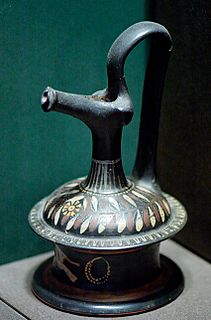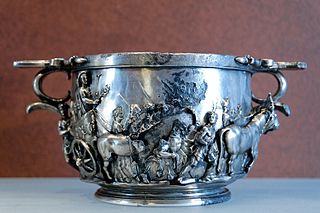
In the pottery of ancient Greece, a kylix is the most common type of wine-drinking cup. It has a broad, relatively shallow, body raised on a stem from a foot and usually two horizontal handles disposed symmetrically. The main alternative wine-cup shape was the kantharos, with a narrower and deeper cup and high vertical handles.

Black-figure pottery painting, also known as the black-figure style or black-figure ceramic is one of the styles of painting on antique Greek vases. It was especially common between the 7th and 5th centuries BC, although there are specimens dating as late as the 2nd century BC. Stylistically it can be distinguished from the preceding orientalizing period and the subsequent red-figure pottery style.

The Amasis Painter was an ancient Greek vase painter who worked in the black-figure technique. He owes his name to the signature of the potter Amasis, who signed 12 works painted by the same hand. At the time of the exhibition, "The Amasis Painter and His World" (1985), 132 vases had been attributed to this artist.

The pottery of ancient Greece has a long history and the form of Greek vase shapes has had a continuous evolution from Minoan pottery down to the Hellenistic era. As Gisela Richter puts it, the forms of these vases find their "happiest expression" in the 5th and 6th centuries BC, yet it has been possible to date vases thanks to the variation in a form’s shape over time, a fact particularly useful when dating unpainted or plain black-gloss ware.
The Comast Group was a group of Attic vase painters in the black-figure style. The works of its members are dated to between 585 and 570/560 BC.
The artists of the Komast Group are seen as the successors of the Gorgon Painter. Its most important representatives were the KX Painter and the slightly later KY Painter. They painted vases shapes that had been newly introduced to Athens or that had not previously been painted. Especially commonly painted by them were '’kothon’’ and lekanis. From Corinth, then still the centre of Greek vase painting, they adopted the Komast cup and the skyphos (known as kotyle. The KY Painter introduced the column krater. Also popular at the time was the kantharos. The group adopted the Corinthian habit of depicting komasts, after which the group is named. It provided the group’s most commonly painted motif. The komast scenes permit Attic artists for the first time to reach the artistic levels of middle-ranking Corinthian vases. While the older KX Painter still mostly painted animals and only the occasional komast scene, the komos became a standard motif for the KY painter and further inferior successors. It is not clear to what extent the painters of the group really cooperated. It is possible that they all worked in the same workshop. The group influenced later Attic vase painters, including the Heidelberg Painter.
Works by the Komast Group were not only found in Attica, but appear to have been exported widely. Vases and fragments have been found at many sites, including Naukratis, Rhodes, Central Italy, Taras, and even Corinth.
The Oxford Palmette Class is the name given both to a class of ancient Attic '’kylikes’’ and to the group of vase painters that made them.

The KX Painter was an Attic black-figure vase painter. He was active between 585 and 570 BC.

The KY Painter was an Attic black-figure vase painter. He was active between 585 and 570 BC.

The Komast cup is a cup shape at the beginning of the development of Attic drinking cups. Komast cups were widespread especially in Ionia and Corinth. Like other vase painters of the time, the Attic painters were under strong influence from Corinthian vase painting.

The Polos Painter was a vase painter of the Attic black-figure style. His works date to c. 575 to 565 BC.

The C Painter was one of the most important Attic black-figure vase painters. His works date to circa 575–550 BC.
His conventional name was allocated by the archaeologist John Beazley. The C stands for "Corinthianising", a reference to the strong influence of Corinthian vase painting on the artist. He was successor to the Comast Group and used the relatively old-fashioned range of vessel shapes preferred by that group, including '’lekanis’’, tripod kothon and skyphos. In contrast, he also painted quite innovative lekythoi with pronounced shoulders, although the more conservative Deinaeira type was still in use by some workshops at his time. The C Painter was the first Attic vase painter to paint cups without an offset lip, the Merrythought cup.

Little-master cups are a type of Attic black-figure cups, produced around the middle and third quarter of the sixth century BC. Their name is based on their fine small-format decoration.
Little-master cups are later in origin than Siana cups, but both types were produced over a considerable period of time. The Little masters painted only the small upper frieze above the carination of the cup, at times also the lip or handle areas. It is probably that only few of the painters of Siana cups also painted Little-master cups. One of the first artists to introduce the Little-master cup in Athens was Kleitias. The change in decoration went along with a lengthening of the cup foot. The dedicated painters of Little-master cups rarely painted larger formas, whereas painters primarily specialised in large vases are known to also have painted Little-master cups. Stylistic comparison between larger and smaller formats of the period remains difficult.

Hermogenes was an Attic potter. He was active in Athens in the mid-6th century BC and belongs to the group known as the Little masters.
Hermogenes mainly produced cups (kylikes). Well-known are his Band cups with depictions of women's heads on the band. The Hermogenic skyphos, a specific type of skyphos with decoration resembling that of band cups is named after him. Hermogenes was an innovative potter. For example, similar to the potter Amasis, he made Lip cups with feet derived from those of Siana cups.

A Siana cup is a type of Attic cup decorated in the black-figure technique. They are named after one of their find locations, the necropolis of the ancient city of Siana on Rhodes. During the second quarter of the 6th century BC, Siana cups were the predominant cup shape in Athens. The shape remained popular later and was still being produced in large quantities during the era of the Little-master cups.
Elbows Out is the name given to an Attic black-figure vase painter, active in Athens around 550/540 to 520 BC.
His conventional name is derived from the strongly exaggerated gestures and odd anatomy of his dancing figures. Together with the Affecter, he is considered one of the mannerists of the black-figure style. He painted e.g. lip cups and neck amphorae, the latter in a special shape with a heavy ovoid body. His amphorae are decorated with several friezes. His band cups resemble works by Tleson and Lydos, but are more conventional in terms of the animal motifs. He also painted a lydion, a vase shape very rarely produced by Attic potters. He is often seen as connected with the Affecter, but also with the Amasis Painter. The link with the latter should not be overestimated.

The Pontic Group is a sub-style of Etruscan black-figure vase painting.

Gnathia vases are a type of pottery belonging to ancient Apulian vase painting of the 4th century BC.

The Theseus Painter was a decorator of vases in the black-figure style, active in Attica c. 515 to 475 BCE. He was the leading producer of larger Heron Class skyphoi.
The kothon black figure tripod is from Boetia and dates back to the sixth century B.C. It is made of ceramic and portrays three different figural scenes: one with athletes, one with ritual dancers (Komasts), and one with a drinking activity, on each of its legs. Its creation is attributed to the group of vessels known as the Boetian Dancers Group and is currently held at the Dallas Museum of Art.



















